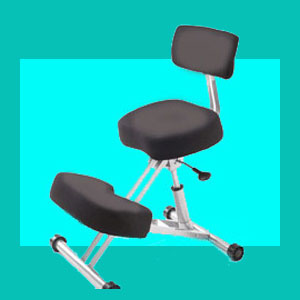
A kneeling chair for herniated discs might provide some degree of relief while sitting, when compared to the regular seated posture offered by a standard chair design. Kneeling chairs have been used for decades to reduce strain on the lumbar spine, as well as to provide a muscle-building, posturally-ideal ergonomic platform for seated work duties.
Kneel chairs are somewhat controversial, since there is little objective evidence that they are superior to traditional chair designs or that they actually benefit back pain sufferers. Additionally, due to their potentially very high cost, many patients might be hesitant to compare a kneeling chair to their present chair, since investment in a quality product can be a pricey consideration.
This essay seeks to define kneeling chairs and explain their applications for herniated disc care. We will also provide an editorial review of some different styles to help patients better decide if a kneeling chair might be a worthwhile investment for providing lumbar disc pain relief.
What are Kneeling Chairs for Herniated Discs?
Kneel chairs are specially-designed seating furniture items that alter the traditional seated posture in favor of a position that is theorized to reduce stress on the lower back, buttocks and upper thighs.
The seat of a kneeling chair slants downwards at a mild angle, preventing the buttocks from carrying the entire weight of the body. Meanwhile, there are shin and/or knee supports that allow the sitter to support themselves and prevent them from sliding forward off the front of the seat surface. These supports are also angled inwards for comfort and stability.
Kneeling chairs for herniated discs might be little more than angled stools, with knee or shin rests. Others might be extremely intricately-designed ergonomic office-style chairs with backrests, various adjustable customization options and richly padded surfaces. Many fall in between these two extremes, offering some options, while still keeping the design simple and less costly.
There are several famous brand-name kneeling chairs, but now, there are also many far less expensive generic options that duplicate the design and functionality of the more exorbitant models, at a fraction of the cost.
Kneeling Chairs for Bulging Discs
Exponents of kneeling chairs claim that these devices change the angle of the spine while seated, thereby lessening the pressure placed on the lumbar region by minimizing the degree of bend in the region. Additionally, pressure is removed from the buttocks and upper thighs. The tradeoff is that some of the back and core muscles must work harder in order to maintain proper posture. This can be a great boon for some, since this work can increase core strength. However, the position might be very uncomfortable for others, especially as they first acclimate to the device.
There is little objective scientific evidence showing that people with intervertebral herniations will definitively benefit from changing to a kneeling chair. If a lumbar herniation happens to reside in the bent area of the back, the odds of a kneeling chair providing relief increase slightly, compared to other areas of the vertebral column. However, patients with cervical and thoracic herniations have also reported relief through the use of kneeling chairs. The best evidence of beneficial activity comes in patients who have known mechanisms that create increased neurological compression when seated.
Sciatica sufferers fare much better in objective testing and many patients with chronic sciatic nerve symptoms prefer the seated posture offered by a kneeling chair. This is logical, given the obvious reduction in pressure on the anatomical components that surround this largest of all bodily nerves.
Since virtually all of the research that has been used to establish kneel chair efficacy has been generated by the chair manufacturers themselves, or by consultant doctors, chiropractors and therapists who have been hired by these same companies, it is difficult to ascertain how much truth exists in benefit claims and how much is simple salesmanship. This is a common problem within the back and neck pain product arena, as we all surely know.
Kneeling Chair for Herniated Discs Editorial
We have enjoyed the privilege of testing many of these chairs at trade shows and health fairs for over a decade. We have seen virtually every style offered worldwide. The cost of kneeling chairs ranges wildly, with some furniture pieces being available for less than the price of an ordinary chair and others being priced far into the luxury goods marketplace.
Our experience places low end chairs in the $25 to $75 range. These are more like low stools that are angled and provide lightly padded seats and knee/shin supports. Virtually all of these are made of simple wood designs or composite plastic.
Moderately-priced chairs range from $100 to $400 and encompass a plethora of design options. Some of the custom options include height or angle adjustments via screws or hydraulics, backrest or no backrest, fit and finish choices ranging from material to vinyl to cheap leather, and wheels or no wheels for mobility at a large workstation. Some of these chairs are styled like complicated office chairs, while others resemble high stools that place the user into a modified sitting/standing posture.
Expensive chairs exist over $400 and can range into the several thousand dollar range. These devices are often made from high-tech materials and luxurious seating surfaces. Some of these kneeling chairs are ridiculously adjustable, for a truly customized fit.
All this being said, our panel has evaluated many designs and has not really seen any that make significant comfort improvements for most lumbar herniated disc patients. In fact, a few chairs seemed to make the sitting problem worse, particularly when the chair was first utilized.
To summarize, we do not universally endorse the use of kneeling chairs, but we surely do not discourage patients from trying them out for themselves. After all, comfort is a very subjective criterion and if a chair can provide relief, then this is a great thing. Sitting is a must-do activity for many of us and a kneeling chair might just be the perfect solution for some patients with particular types of lumbar herniations.
If you do purchase a kneeling chair for herniated discs, please share your usage experience on our social media pages. Other patients would love to know how the device worked for you. Thank you. Companies that feel that their chairs deserve individual evaluation can contact us to arrange a review.
Herniated Disc > Herniated Disc Products > Kneeling Chair for Herniated Discs





